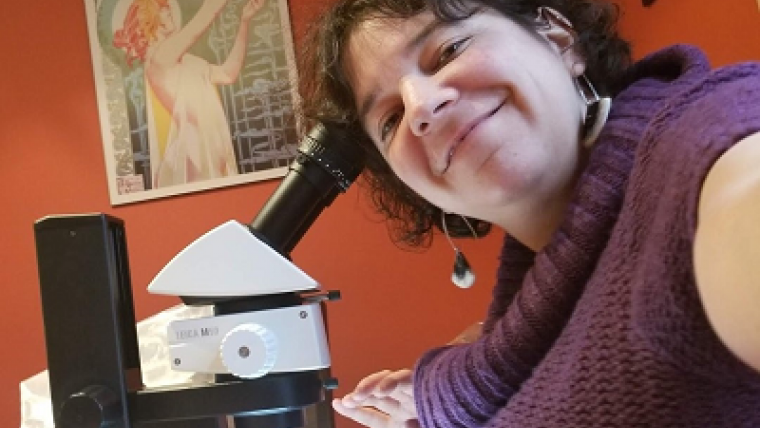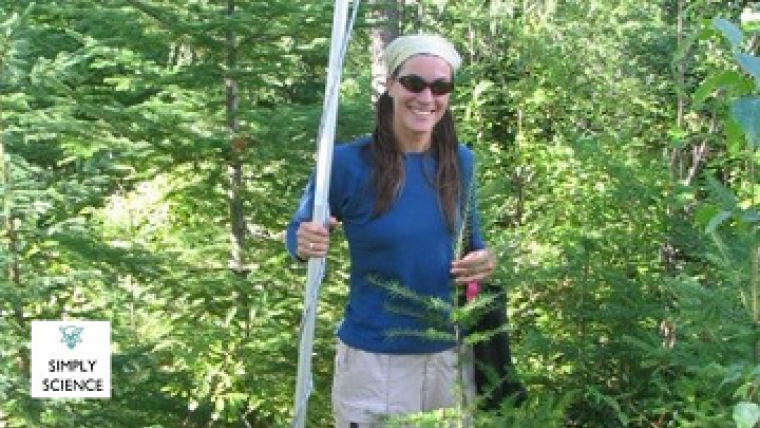Discovering the Elm Zigzag Sawfly in Canada
The elm zigzag sawfly, an exotic insect found in Asia and Europe that feeds on elm trees, has never been found in North America… that is until now. On this episode, we talk about how a photo by a nature photographer lead to the discovery of the insect on this side of the pond.
Transcript
Joel Houle
When you go about your daily life, if you’re anything like me, you probably don’t often take the time to truly take everything all in, everything that’s happening around you. You know: life is busy. But imagine when you do take that moment to let it all sink in. Who knows what you just might discover? On this episode, we talk about one such discovery when a nature photographer saw an interesting pattern on a leaf that got entomologists buzzing.
Welcome to a new episode of Simply Science, the podcast that talks about the amazing scientific work that we do here at Natural Resources Canada.
My name is Joel Houle. And joining me today is my co-host and nature photography enthusiast, Barb Ustina. Barb, how are you?
Barb Ustina
I’m doing just great today. How are you doing?
Joel Houle
I’m doing great. So why don’t you tell us a little bit more about all this nature photography that you’ve been doing?
Barb Ustina
Well, I love doing nature photography. I have to admit I’m not really great at it, but I like to try. And one of the great things about living and working in Ottawa is that we have the Arboretum. We have the experimental farm. Gatineau is not too far away. And I love to go walking with my dog and take my camera out and take a few shots. How about you, do you get out there very often?
Joel Houle
Not that often. But I do enjoy nature walks and, like a lot of things in my life, I like to pretend that I am a photographer. So I do have a nice camera. I brought the family actually on a trip ...
Barb Ustina
… there’s my dog! I think he wants to go to the Arboretum right now and do some photography! He’s really anxious to get out there!
Joel Houle
Yeah, for sure. Especially this time of year. It’s so nice out. I remember about maybe about a month ago I took my family out to Jack Pine Trail — it’s in the west end of Ottawa — and it’s all these nice trails in the forest. And there’s a lot of little birds there. And actually, if you put some bird seed in your hand and you hold it there, birds will actually come in your hand and eat and take some of the bird seed. It’s really great! And I brought my camera. I put on this fancy lens, and I’m all ready, and birds are coming, and I’m taking some pictures. And I look at them after, there’s like 35 shots and not a single one is in focus. So, yeah, I think that my potential career path as a photographer is not going to happen.
Barb Ustina
Well, good for you for getting out there with a real camera, with lenses and filters and things like that. Because I do all my work on my smartphone, and it’s got that really glossy cover on it, and I can’t even see what I’m shooting. Sometimes I just sort of point and hope that things are in focus, and I’m always surprised at what I come back with. So that’s kind of fun. And I’m pretty sure that none of my photographs would ever lead to a Canada-wide search for an exotic insect or anything like that. But it’s fun anyway.
Joel Houle
Yeah, my strategy is to fake it until you make it. So at least it looks like I know what I’m doing. So I’m curious to see actually how a real nature photographer’s photo actually led to an interesting discovery. Should we bring in our guest?
Barb Ustina
Sounds good!
Joel Houle
Joining us today is Véronique Martel from the Laurentian Forestry Centre. Véronique, how are you?
Véronique Martel
I’m good, thank you. I’m getting used to teleworking, but I have to say that I miss my colleagues.
Joel Houle
Yeah, you’re not the only one. I miss spending every day with Barb.
Barb Ustina
Oh ....
Joel Houle
I know, right? I’m starting off on the right foot. So, Véronique, you’re a research scientist in entomology. Can you explain to us the type of work that you and your colleagues do?
Véronique Martel
I work in entomology, which means that I work with insects. And of course I specialize in the insects present in forest. So basically, we are studying pest species affecting trees, and we’re trying to understand them better and also trying to find management tools to try to reduce their impacts on the forest and the trees.
Barb Ustina
Now you’re here today with us to talk about a very exotic insect that was spotted in Canada for the very first time ever this past summer. Can you tell me a bit about the story of how it was discovered and how you reacted when you first heard about this insect?
Véronique Martel
Yes. There’s a citizen science website called iNaturalist, where people can post pictures of any animals or plants they see. And in the end of July, someone posted a picture of an elm leaf with zigzag defoliation, which is kind of pretty. And he thought it was caused by a caterpillar, which is what it looked like. But someone saw it on the website and realized that it might actually be caused by a species that has never been found not only in Canada but in North America before, coming from Asia originally. So they contacted a few people working in the field of entomology. And I got the email, and the Canadian Food Inspection Agency also got the email. So we decided to go and have a look in the place it was found and try to find the insect to make sure if it was this new exotic species or not. And after sending one specimen to a taxonomy lab, we actually realized that it was this new exotic species called the elm zigzag sawfly.
Joel Houle
Can you tell us a little bit about this insect?
Véronique Martel
It’s a sawfly, so it’s in the same group as bees or wasps or ants. The larvae are the stage causing the damage. So they feed on elm trees. They are specific to elm trees but can affect different species of elms. And what’s kind of ideal, if I might say for an exotic species, is that it’s easy to spot because they really do create a clear zigzag pattern when they feed. So they start from the edge of the leaf and will zigzag in between two veins of the leaf. And so it makes it really easy to see it. But yeah, it feeds like that. But it can make three to four generations per year, which is a lot. A lot of species like spruce budworm will make only one generation, so it goes through each phase in a year, but this one can make three to four per year. So it means that it’s really quick and also can increase in population really, really quickly. So that makes it also a species that is really good to establish in a new place like Canada, for example.
Barb Ustina
That’s amazing! So the population grows exponentially. Can you give me an idea of how much damage this insect can potentially cause?
Véronique Martel
As it makes many generations per year, it means that you have like three to four batches of insects feeding per year. So it means that it can cause pretty heavy defoliation if the population gets high enough. But it doesn’t seem to cause a tree’s mortality, at least in Europe, where it’s been introduced like 15 years ago, or in Asia. So it might reduce the growth of the tree, if there’s really heavy defoliation, but it doesn’t kill the entire tree, which is the good news. But the thing we need to keep in mind is that elm trees already have a disease, the Dutch elm disease that’s been there for a long time. And the combination of the two, the elm zigzag sawfly and the Dutch elm disease, might be a deadly combination for the trees. But alone, the insect won’t kill the trees, or at least it doesn’t seem so in Europe and Asia.
Barb Ustina
Now how is it that it’s able to expand its population so exponentially, so fast? Is there something special about this insect?
Véronique Martel
Well, apart from the fact that it makes several generations per year, another thing is that the females, when they emerge, normally, females would have to mate with a male in order to be able to lay eggs. But in this species they don’t need to. So the females are already ready to lay eggs without having to mate. So there’s actually no males that have been found in this species. So that is called thelytoky. When they can reproduce, the females will produce females without even mating. But that means that they can lay eggs right away. And it’s another factor increasing their ability to be a really growing population and establishing a new place.
Joel Houle
So you mentioned that they’re originally from Asia and that they are also found in Europe. So I’m kind of curious, how do they make their way here? Last episode, we had someone talked about the Asian longhorn beetle and how the wood that’s used for cargo shipping is one way that the beetle can cross to North America. Is that the same case for this sawfly?
Véronique Martel
We don’t know exactly how it got here, so we’re currently looking at the genetics to try to identify where it’s from. But independently of where it came from, we don’t know exactly how, but we do know that it’s not present in the wood. So it’s really only on the leaf. And then it will go to the ground during winter making the cocoon. So we need either cocoons in the soil or leaves having larvae on them to be able to move it. So we’re not sure exactly how it got in. Is it through some leaves that were on trees, but normally the trees that are imported don’t have leaves on them? Or is it through soil because of cocoons? It’s still not clear how it got here.
Joel Houle
What are we doing right now to manage the situation? Is it possible to eradicate this sawfly?
Véronique Martel
I don’t think it’s possible. One of the reasons is that it’s probably more spread than we think already. So it has been discovered in one place in the south of Quebec, in Montérégie at first. But then once we realized that we posted stuff on Twitter or iNaturalist to have people look around and look at elm trees in their place, then we actually realized that it was already kind of spread in Montérégie, but it was also present in Montreal and maybe north of Montreal. So it’s probably too late to eradicate it because it might be more dispersed than we thought at first. So for now, it’s currently ’too late because it’s fall, so we need the leaves in trees to actually detect it. But next summer we’ll work on that with the Canadian Food Inspection Agency to try to find where it is exactly and try to have a better picture of its situation currently in Quebec or Canada.
Joel Houle
Does the cold affect the sawfly at all?
Véronique Martel
Well, there has been one study made by a Hungarian team, and it seems like they’re pretty good at resisting cold. And the other thing is that as they fall on the ground to make their cocoon, they’re probably protected by snow. So it’s not likely that the cold will be a factor affecting it in Quebec.
Barb Ustina
It sounds as if the insect will be dormant over the winter months. And so people are sort of on hold until next spring. For someone who’s listening right now, if they want to get involved like a citizen scientist come spring, what can they do? What should they look for? How can they get involved?
Véronique Martel
Well, the first thing is to identify elm trees. Elms are pretty easy to find. They have serrated leaves, and the base of the leaf is asymmetrical. So that’s kind of easy. It’s easy to find pictures also on the Web. So that’s the first step. Once some of those elm trees are around their place, it’s just keep their eyes open, look at the leaves, and try to find the zigzag pattern in defoliation. Once this pattern is detected, it’s pretty specific to that species. But of course, we always like to confirm that it’s really that. But then they can come back; the Canadian Food Inspection Agency, through their website; they can come back to myself. Or they can also post their observations on iNaturalist, for example, and then myself or other people from the group will probably go and have a look on-site to try to find the insect. Because the official sighting of an insect is a specimen that’s just traces of the insect. Keep your eyes open, look around, look at elm trees next spring and summer. And if you see anything that might look like a zigzag, just let us know.
Barb Ustina
How common is it for a new insect to be discovered in Canada? Is that something that you see every year, every ten years, every month? Do you have any idea how often this happens?
Véronique Martel
There are probably many new species coming to Canada, but we don’t always realize it. So it, of course, depends what it affects. If it affects the economy, if it affects other species, then we might be more likely to see it. But it’s probably something that’s kind of come in. I don’t want to give numbers because I’m not sure about that. But sometimes species are seen in, I don’t know, on ships in wood packages, and they’re stopped before they come in because the Canadian Food Inspection Agency is really looking for that. They have inspectors looking at packages that ship all these things, and they make sure that if there’s anything suspicious, they stop it. So we’re probably able to stop part of them from coming. And that’s why we have all these regulations that are sometimes annoying. Even when we travel for vacation, we can’t bring back everything we want because of that. But that’s necessary because it’s preventing exotic species from coming here and disrupting the ecosystem.
Joel Houle
Yeah, I guess there’s a good reason why those regulations are in place. Véronique, thank you so much for taking the time to come and talk to us today.
Véronique Martel
Thank you.
Joel Houle
That was a great interview! It was super-interesting to hear about how important citizen scientists are to the whole discovery process. I guess scientists and researchers can only do so much. So having the support from citizen scientists to have eyes and ears on the ground or gather information, I guess it could be crucial to the success of a project.
Barb Ustina
Oh, for sure. And when you think about it, look at the size of Canada. We are a huge country. It would be impossible for anyone or any scientist to try to cover the entire country. So having those eyes and ears on the ground is really important. And it’s encouraging to see how many people like to get involved. One great example is the Spruce Budworm Tracker Program, and this involves dozens of citizen scientists from Prince Edward Island, Nova Scotia, Newfoundland, Ontario and even as far away as Maine. Their input is vital, and every year they help monitor how populations of spruce budworm rise and spread.
Joel Houle
So if any of you out there are interested in learning more about opportunities for participating in citizen science, or you want to learn more about specifically about the topic of today’s conversation, which was the elm zigzag sawfly, we’ll have lots of links in the description so you can check those out. You can also leave a review or share this episode. And if you share over Twitter, make sure to tag us @NRCanScience. That’s our new Simply Science Twitter account. Or you can actually tweet at us directly. I’m @JoelScience...
Barb Ustina
… and I’m @SimplyScienceB, that’s the letter B. And I might remind everyone that Simply Science has a brand new social media channels: Facebook, Twitter and Instagram. Have you followed us yet, and what are you waiting for? Don’t forget Simply Science also has a website and a YouTube channel, which you should also check out. You’ll find in-depth articles and videos that showcase the fascinating scientific work we do at Natural Resources Canada. And you can find those links in the episode description as well.
Joel Houle
Thank you, Barb, and thank you so much, everyone, for listening. We’ll see you in the next episode.
Barb Ustina
Bye!
- Citizen scientist spots a newcomer on Canadian elm trees (Simply Science article)
- Citizen Science Portal (Industry Canada)
- Slowing Down the Spruce Budworm (Simply Science podcast)
- International Year of Plant Health 2020
- Véronique Martel on Twitter
Page details
- Date modified:


